How To Clean A Rusty Iron? Check Out The Natural Ways
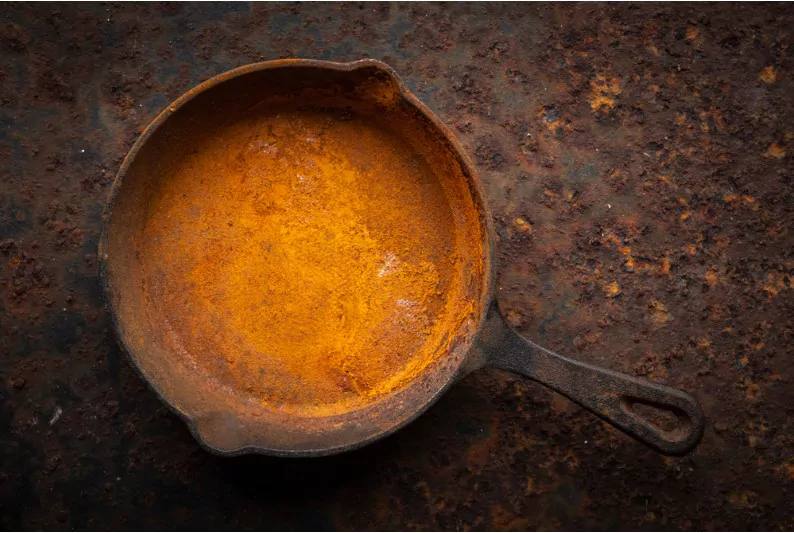
Cast iron cookware offers durability, non-stick properties, and heat retention, all of which make it a great option for a variety of cooking tasks. It is difficult to break down cast-iron cookware because they are sturdy, nonstick, and can last for decades. Despite this, cast iron cookware does have a few disadvantages as well. They are prone to severe rust!
In contrast to modern stainless steel cookware and Teflon-coated aluminum cookware, cast iron can easily rust when exposed to water. Fortunately, gentle abrasives and a few drops of elbow grease will help you get rid of the cast iron rust and add a protective layer to the seasoning process.
No matter what sort of cast iron you’ve acquired, whether it’s vintage cast iron with years of use or neglected to dry after washing, there are a few simple steps you can follow to clean and remove all the rust and improve the appearance of your cookware.
1 What causes cast iron to rust?
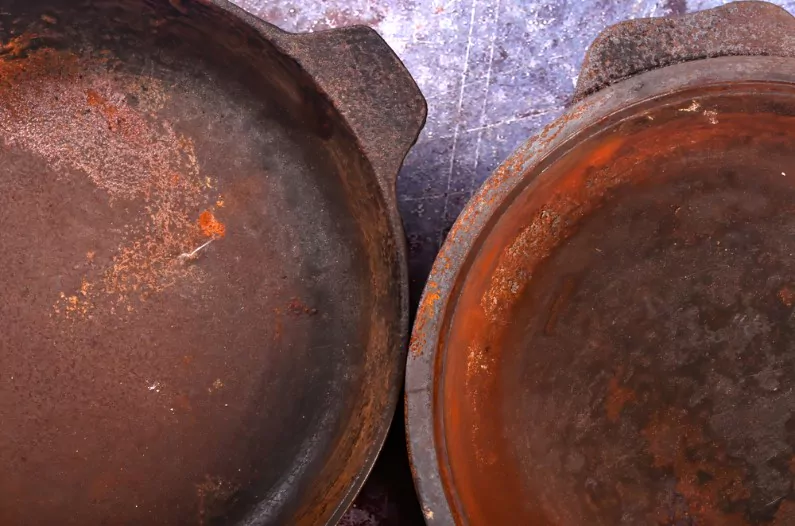
Cast iron cookware is composed of different elements such as alloys, steel, and an iron compound – pig iron. The reactions between iron and oxygen and water result in rust also known as ‘iron oxide’. In other words, if water is left on cast iron for a longer duration, it will rust. To prevent damage to your skillet and metallic taste while cooking, you should not use one while there is rust on its surface.
Cast iron cookware is likely to rust if it is not seasoned properly. However, there are also chances for your pan to rust from other sources of moisture. With cast iron being porous, some residual moisture may remain on the surface of your pan if you simply dry it with a towel. So, whenever you wash a cast iron skillet, we always recommend drying it over medium-low heat on the stove to evaporate any residue water from the entire surface.
2 How to clean rusty cast iron skillets?

Here are a few simple steps to remove rust from cast-iron skillets, Dutch ovens, and even stovetops.
Use a non-scratch scorching pad or a stiff brush
Depending on the level of rust, you can use steel wool or a mild scrub brush to scrape off the rust from the pan inside. Scrub the entire skillet with a little water and mild dish soap if it is stubborn.
Concentrate your efforts on parts of the rusty cast iron skillet, and scrub in small circles. As you scrub, you will see the original black iron of the cast iron skillet coming to the surface.
Use baking soda to remove mild rust
Baking soda can be used as a scrub by spreading a small amount along with some warm water onto the surface with any chemical burns on the rusty skillet.
Make a very thin layer of paste with water and baking soda, then scrub the paste into the rusty spots. After you scrub off the rusty patches and any particles of the food stuck in the cast iron skillets, allow the paste to sit on the surface of the pan and wash the cast iron skillet under running water.
Dry the cast iron skillet completely
After you are done removing rust from the cast iron skillet, you should see almost no signs of wear on your cast iron skillet now. You can use paper towels or a lint-free cloth to completely dry your cast iron skillet.
In order to ensure it is thoroughly dry, you can place your cast iron skillet on the stovetop on low heat for a few minutes.
3 How to remove rust from a rusty cast iron pan?
Use kosher salt to remove the rusty patches
Kosher salt is a great abrasive to remove rust and any stuck-on food from cast iron pans. Almost the same as we saw the baking soda method, this one works by mixing salt and hot water in a pan, then rubbing it on rusty areas on the entire pan.
In comparison to baking soda, salt crystals are a little larger and have a rough texture, making the paste a little more abrasive.
Use vinegar
If you can’t eliminate rust from your cast iron pan with simple scrubbing, add a few drops of vinegar along with warm water. After a short time, you will notice the formation of small bubbles and the liquid will turn slightly cold.
Let the thick paste sit for an hour and let it show its magic! You can now continue to scrub the paste gently on the rusty patches. Wipe the cast iron pan with a paper towel.
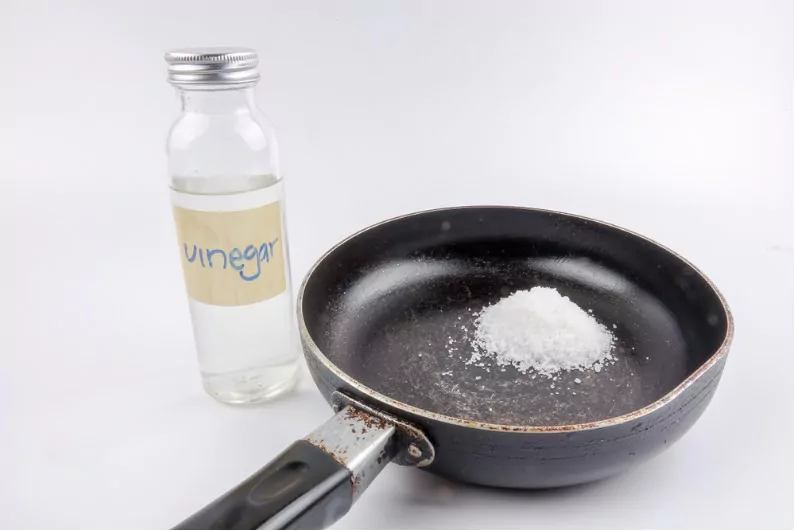
Use soapy water
Another remedy to scrape off the rust easily is to use soapy water. If you don’t want to go with any of the above-mentioned, a mixture of soapy water will be enough to get rid of small areas of rusted cast iron pan.
Add about one tablespoon of any detergent or soap with hot water. Start by gently scrubbing the entire pan with a ball of steel wool. Doing so will remove most of the rust linings in old pans or if you have any rusted brand-new pans.
Let the cast iron cool and air dry
Following the scrubbing, you may need to dry your cast iron pan. If you let the water sit on the pan for too long, it may start to rust again. Use any lint-free cloth clean or a paper towel to get rid of excess water on the pan. To make sure the cast iron pan is completely dry, place it on the stovetop on low heat.
4 Seasoning and re-seasoning cast iron pans
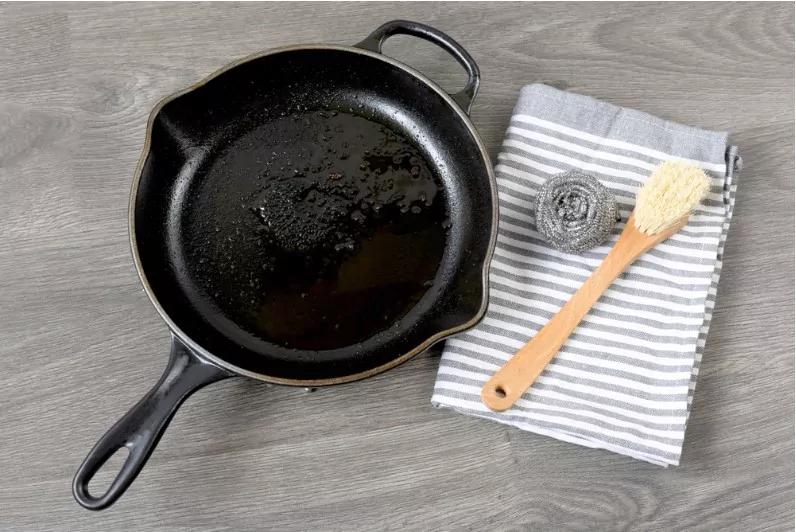
Pre-heat the oven
Seasoning involves ‘baking’ a layer of fat on the pan so that it remains semi-permanent. The antioxidant properties of fat protect cast iron from rusting. Start with pre-heating the oven to 177 degrees C.
Make sure to coat the pan with neutral oil
Put a thin layer of cooking oil on the entire pan, mainly the cooking surface. Do not cover the pan with too much oil. You can use any oil including canola oil, vegetable oil, or corn oil.
Drop 1 tablespoon of oil over it and make sure to cover the entire surface of the pan with a paper towel.
Place the pan upside down and wipe off any amount of excess oil.
Bake the pan upside down on a foil-lined baking sheet
The next step is to insert the pan into the preheated oven. To catch any excess oil, place aluminum foil on the bottom rack. Stack your cookware upside down inside the center rack.
By doing this, the oil does not pool on the cooking surface. This process is known as polymerization. Where the polymerized oil is heated at high heat, changing its form from liquid to a thick and hard solid texture.
Let the pan bake at high heat
The pan should remain flavorful for 45-60 minutes at 177 degrees C after it burns off all the excess cooking oil and gets back to its original seasoning.
Turn off the oven after an hour. Do not open the oven cleaner handle.
Cool down the pan
Let the hot pan cool slowly. Give it another few hours to cool down naturally. As soon as the pan is cool enough to handle, remove it from the oven. Now that you have your well-seasoned pan, you can enjoy it to cook any dish you like without worrying about the food sticking to the pan.
However, you should avoid cooking acidic foods as much as possible with a seasoned cast iron pan. If you wish to re-season the cast iron pan, just add a few drops of oil to the surface while you cook.
5 How to clean a rusty iron, enameled cast iron, and Dutch oven
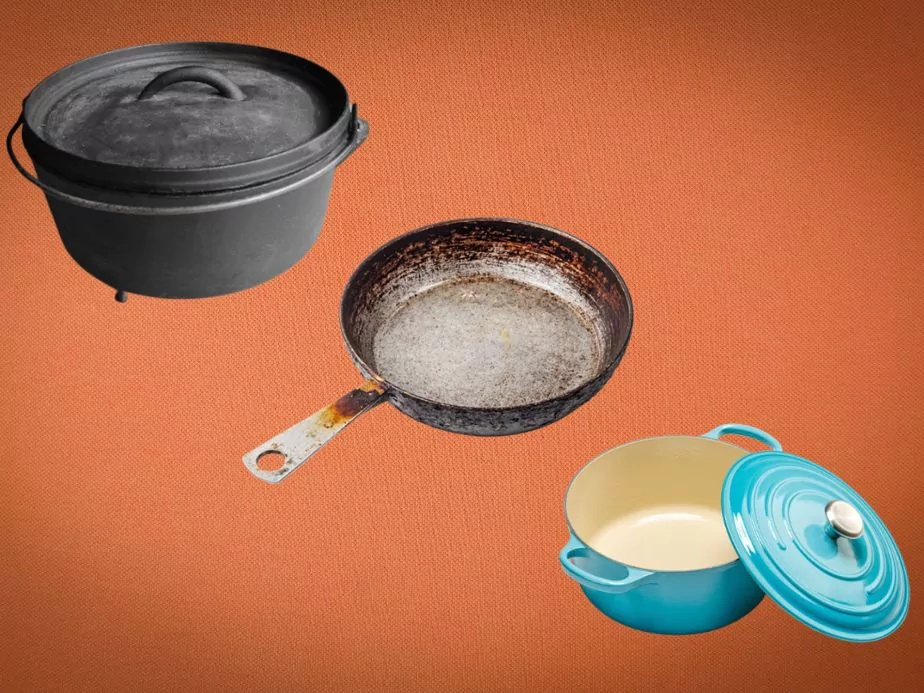
Unlike rusted cast iron, enameled cast iron does not need to be seasoned before use. Even though most enameled cast iron is safe with dishwashers, many manufacturers insist on cleaning such pieces by hand to keep the enamel from being worn away.
Allow the cast iron to cool before heating to prevent thermal shock, which might warp or crack the pot. Avoid using any kind of abrasive scrubs, balls of steel wool, or strong detergents. These could scrape off the enamel coating and even damage the cooking surface of the pan.
It is normal for the enamel to dull over time and for some staining to occur, but neither will affect your cookware’s performance.
6 Wrapping Up
Concluding the article, we hope that you might have gained some knowledge on how to easily scrape off the stubborn rust from your cast iron cookware. Try these hacks and let us know in the comment section which of the following worked the best for you!
FAQ's about Cleaning a rusty cast iron
Does salt remove rust?
Yes, salt is a great abrasive to remove rust and any stuck-on food from cast iron pans. Mix salt and hot water in a pan, then rub it on rusty areas on the entire pan. The reason why salt removes rust is that salt water, which is an electrolyte solution, contains more dissolved ions, which means that electrons can move more readily in salt water than in freshwater. Apply the paste on the rusty patches, and scrub off the paste with the rust and polish the surface with a lint-free dry cloth.
How long does it take for rust to dissolve in vinegar?
White vinegar is proven for removing stubborn rust. You can combine vinegar and salt water for removing rust on any metal, especially cast iron. Apply the paste of vinegar and salt water and allow it to sit for 12-24 hours in case of severe rust. After soaking the metal, remove the paste with a steel wool and wash the metal under running water.
What liquid can remove rust?
Acids are the best liquid which can remove rust very easy and efficiently. Particularly, sulfuric acid, acetic acid, hydrochloric acid, and phosphoric acid are widely used to remove rust and corrosion formed due to oxidization.
How do you remove rust naturally?
Soak your cast iron cookware in a paste of vinegar mixed with salt water. Let the thick paste sit on the cookware overnight and do its magic. Now, scrub the rusted area with a steel wool and place it under a tap of water. You will notice the rust being removed naturally. The next step is to clean the cookware with a lint-free cloth and dry it thoroughly.
What household chemical kills rust?
Household chemicals like vinegar, lemon juice, salt, and baking soda are the most popular chemicals proven for killing rust. Keep on reading to know the complete step-by-step guide on how to clean rust easily with these easily available household chemicals.
Community Q&A
About This Article
This article has been viewed 640 times.



